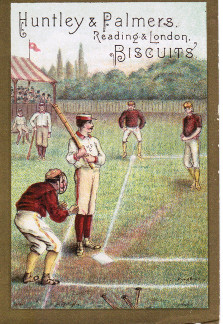Although Americans had played baseball both before and during the Civil War (1861-1865), "the game experienced phenomenal growth after 1865." Workers in their spare time played baseball, children played baseball, "gentlemen" in clubs played baseball. Baseball's earliest players were "amateurs" meaning they were not paid to play. At the same time, large crowds would often watch many of these amateur games. In their desire to excel (meaning win), many teams and their growing number of followers began to search for superior talented players. Gradually, the amateur players on some teams were replaced by "professional" (meaning paid) players.
Entrepreneurs saw the opportunity for possible profit at the same time as civic pride demanded that any town of note field a team. The best players gravitated to the teams that paid the most money. In short, "the popularity of baseball led to professional baseball" played by full-time players. These professional teams played not games but "championship contests" out of which evolved leagues. Minor leagues were regional in scope while major league(s) covered a much wider geographical area. Most of this professional growth of baseball occurred during the Victorian era between the 1870s and 1905, a time span which included the heyday of advertising trade cards.
Change and Experimentation
The late 19th century was a time period when amateur baseball was booming and professional baseball was struggling for stability. For both levels of baseball, it was a time of constant rule changes and experimentation as leaders sought to "perfect the game." What should be the ideal distance between the pitcher and the batter? Should a flat edged bat be allowed? What would be the best balance between offense and defense? Should substitutes be allowed to enter a game, and, if so, how many, and when? These questions had to be answered during this time of organized baseball's "infancy."
Meanwhile, players and managers were "inventing" new methods, equipment and strategies. The hook slide, to avoid an infielder's tag, was introduced and perfected by aggressive base runners. Pitchers came up with a wrist-twisting hard-to-hit curve ball and, to keep batters off-stride, threw occasional slower change-up pitches. New and better equipment, uniforms, shoes and gloves were developed. The hit and run strategy was perfected.
Image Problems
There were other serious issues that organized baseball could not ignore. Gamblers had influence on dishonest players and the outcome of games. Some players were "fixing" games. The games were quite popular but unsavory behavior often occurred at games. There was heavy drinking, gambling, profanity and rowdyism. Even the players were an issue. The stereotypical early baseball player was second-generation Irish or German, rough-hewed, uncouth and profane, a heavy drinker and brawler. (Obviously there were many exceptions like evangelist Billy Sunday and lawyer John Montgomery Ward.) Detractors like Harvard president Charles W. Eliot during the 1880s said, "I think baseball is a wretched game. I call it one of the worst games, although I know it is called the American national game."
Professional baseball during the 19th century was aggressive, intense, often harsh, at times bitter. Winning was the objective, the only objective. Players played hard. Players came into bases with flashing spikes. Balls were thrown with intent to frighten or even to hit a batter. Crushing slides were developed to tumble and hinder a fielder. Nineteenth century baseball was often violence-prone and injuries were quite common. Yet, many people, just as many players, loved the game. Much of America was fascinated with baseball. And despite what some clergymen and parents might preach, young boys simply idolized the players.
| 19th Century Baseball Major Leagues (in order of origin) | |
|---|---|
| National Association | 1871-1875 |
| National League | 1876-1899 |
| American Association | 1882-1891 |
| Union Association | 1884 |
| Players Association | 1890 |
"Organized baseball" leagues appeared and disappeared as many owners "fought" other owners in their competing drive for profits. At the same time, players quarreled with owners for free movement from team to team and greater monetary compensation. Early 21st century player-management confrontation is not new. Its roots go back 100 or more years to 19th century precedents. (NOTE WELL: There was no officially recognized American League until 1901.)
